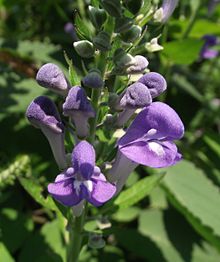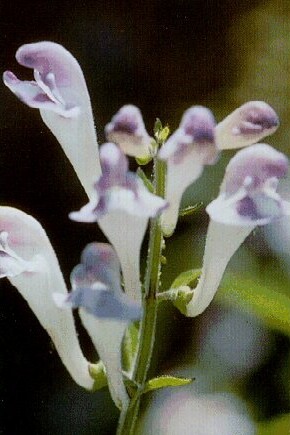
Scutellaria montana, with the common names largeflower skullcap, large-flowered skullcap and mountain skullcap, is a perennial forb first described by Alvan Chapman in 1878. This narrowly endemic species is found in the southeastern United States in parts of the Ridge and Valley and Cumberland Plateau Physiographic Provinces. Populations have been documented from four Tennessee counties and nine Georgia counties and is protected under the US Endangered Species act as it is a threatened species. The Latin specific epithet montana refers to mountains or coming from mountains.
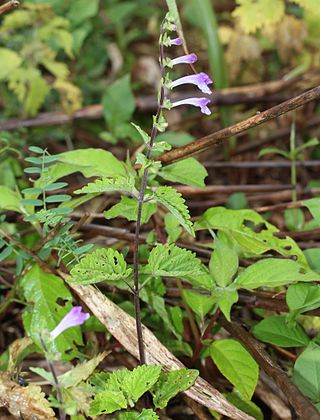
Scutellaria is a genus of flowering plants in the mint family, Lamiaceae. They are known commonly as skullcaps. The generic name is derived from the Latin scutella, meaning "a small dish, tray or platter", or "little dish", referring to the shape of the calyx. The common name alludes to the resemblance of the same structure to "miniature medieval helmets". The genus has a subcosmopolitan distribution, with species occurring nearly worldwide, mainly in temperate regions.

Cunila origanoides, with the common names stone mint, frost mint, dittany, and American dittany, is a perennial late-summer-flowering subshrub with small purple flowers that is native to the central and eastern United States. It belongs to the Lamiaceae (mint) family and is the only species in the Cunila genus native to the United States. It grows in habitats such as dry forests and the thin soil around rock outcrops. This species has historically been cultivated for use as a medicinal herb, tea, and ornamental plant.
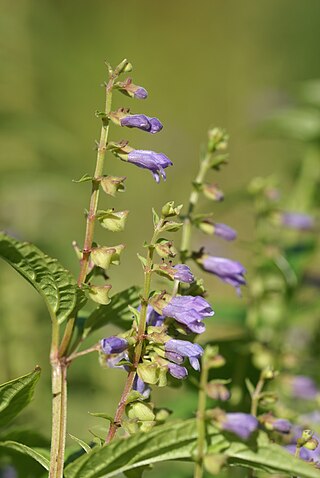
Scutellaria lateriflora, is a hardy perennial herb of the mint family, Lamiaceae, native to North America.

Scutellaria galericulata, the common skullcap, marsh skullcap or hooded skullcap, is a hardy perennial herb native to northern areas of the Northern Hemisphere, including Europe, Asia, and almost all of Canada. It is a member of the mint family. The form is upright and is usually 20-45 centimeters in height, sometimes reaching up to 80 cm. It is a wetland-loving species and grows along fens and shorelines. The blue flowers are 1 to 2 centimeters long. The flowers are in pairs and are all on the same side of the stem. The flowers do not appear at the top of the stem.

Scutellaria ovata, commonly known as the heartleaf skullcap, is a member of the mint family (Lamiaceae). Its range in the United States is from Minnesota to Florida, and from Texas to the Atlantic coast. It is also native to Mexico.
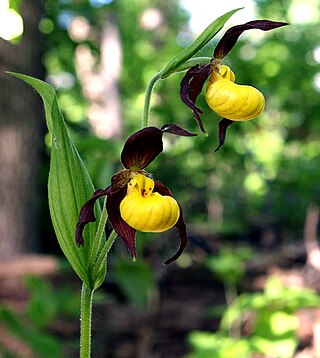
Cypripedium parviflorum, commonly known as yellow lady's slipper or moccasin flower, is a lady's slipper orchid native to North America. It is widespread, ranging from Alaska south to Arizona and Georgia. It grows in fens, wetlands, shorelines, and damp woodlands.

Scutellaria nana is a species of flowering plant in the mint family known by the common names dwarf skullcap and dwarf scullcap. It is native to the western United States, especially in and around the Great Basin. It grows in plateau scrub, often on volcanic soils. It is a small perennial herb producing one or more erect stems up to about 20 centimeters tall from a rhizome. It is coated in tiny flat hairs which sometimes have resin glands. The leaves are oval or diamond-shaped, the lower ones borne on short petioles. Flowers occur in the leaf axils, each borne in a calyx of sepals with a prominent ridge on the upper surface. The corolla is up to 2 centimeters long, tubular in shape, and generally white or yellowish with purple mottling on the lips.

Collinsia verna, or blue-eyed Mary, is a winter annual that is native to the eastern and central parts of North America but has become endangered in the states of New York and Tennessee. The flowers are bicolored white and blue. It is a plant of valley bottoms and moist bottom slopes, in areas with moderate lighting and requires some shade.

Scutellaria antirrhinoides is a species of flowering plant in the mint family known by the common names nose skullcap and snapdragon skullcap. It is native to the western United States, where it grows in forests, woodlands, and open, rocky habitat types. It is a perennial herb producing an erect stem or cluster of stems up to 35 centimeters tall from a system of thin rhizomes. The stems are coated in short hairs which are curled or angled upward and sometimes have resin glands. The oval leaves are coated in tiny hairs and are oppositely arranged. The lowest leaves are borne on short petioles. Flowers emerge from the leaf axils. Each flower is held in a calyx of sepals with a large ridge or appendage on the upper part. The corolla measures up to 2 cm long, tubular in shape with a large upper and lower lip. The upper lip is folded into a beaklike protrusion and the lower has three flat lobes. The corolla is purple to blue with an area of white mottling on the lower lip.
Scutellaria bolanderi is a species of flowering plant in the mint family known by the common name Sierra skullcap. It is endemic to California, where it is known from the Sierra Nevada and several of the mountain ranges to the south. It is a perennial herb producing an erect stem or cluster of stems 30 centimeters to one meter tall from a system of thin rhizomes. The stems are coated in short, spreading hairs which sometimes have resin glands. The oval or heart-shaped leaves have wavy edges and are oppositely arranged. The lowest leaves are borne on short petioles. Flowers emerge from the leaf axils. Each flower is held in a calyx of sepals with a large ridge or appendage on the upper part. The corolla is between 1 and 2 centimeters long and tubular in shape with a large upper and lower lip. The upper lip is folded into a beaklike protrusion and the lower has three wide lobes. The corolla is white or very pale blue with an area of blue mottling on the lower lip.
Scutellaria siphocampyloides is a species of flowering plant in the mint family known by the common name grayleaf skullcap. It is endemic to California, where it is widespread throughout the mountain and coastal regions; it is absent from the deserts and the Central Valley. It can be found in forest and woodland habitat, and a variety of open habitat types. It is a perennial herb producing an erect stem or cluster of stems up to about half a meter tall from a system of thin rhizomes. The stems are coated in short, flattened hairs which sometimes have resin glands. The oval leaves are oppositely arranged. The lowest leaves are borne on short petioles. Flowers emerge from the leaf axils. Each flower is held in a calyx of sepals with a large ridge or appendage on the upper part. The tubular corolla can be up to 3.5 centimeters long and has a large upper and lower lip. The upper lip is folded into a beaklike protrusion and the lower has three wide lobes. The corolla is pale lavender to deep purple in color, sometimes with white mottling on the lower lip.
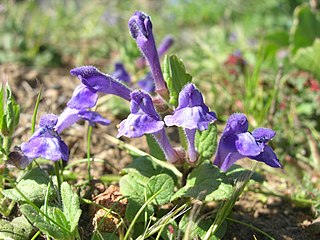
Scutellaria tuberosa is a species of flowering plant in the mint family known by the common name Danny's skullcap. It is native to western North America from Oregon through California to Baja California, where it is widespread throughout the mountain and coastal regions; it is absent from the deserts and the Central Valley of California. It can be found in forest and woodland habitat, and a variety of open habitat types, often appearing in areas recently cleared by wildfire. It is a perennial herb producing an erect stem or cluster of stems up to about 25 centimeters tall from a root system with tubers. The stems are coated in short, spreading hairs. The oval leaves are oppositely arranged. The lowest leaves are borne on short petioles. Flowers emerge from the leaf axils. Each flower is held in a calyx of sepals with a large ridge or dome-shaped appendage on the upper part. The tubular corolla is one to two centimeters long and has a large upper and lower lip. The upper lip is folded into a beaklike protrusion and the lower has three wide lobes. The corolla is deep purple-blue, usually with a white patch or mottling on the lower lip.

Delphinium exaltatum, known by the common name tall larkspur, is a species of flowering plant in the genus Delphinium, part of the buttercup family. Other Delphinium species are also commonly known as tall larkspur, such as Delphinium barbeyi. D. exaltatum is native to the central and eastern United States, where it can be found in Kentucky, Maine, Ohio, Pennsylvania, Maryland, West Virginia, Virginia, North Carolina, Alabama, Tennessee, and Missouri.

Scutellaria alpina, the alpine skullcap, is a species of flowering plant in the mint family, Lamiaceae.
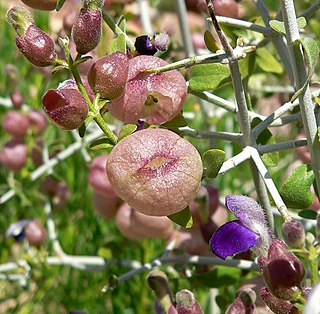
Scutellaria mexicana, commonly known by variants on bladder sage or paperbag bush, is a shrub of the mint family Lamiaceae distinctive for its calyx lobes that develop into small bag- or bladder-like shells around the fruits.

Scutellaria integrifolia, commonly called helmet flower or helmet skullcap, is a flowering plant in the mint family. It is native to the eastern United States where it is found in openings in mesic, acidic soil. It likely requires disturbance in the form of fire to maintain its appropriate habitat.

Balsamorhiza incana is a North American species of plants in the tribe Heliantheae of the family Asteraceae. It is native to the northwestern United States, in Idaho, Montana, Wyoming, Washington, and Oregon.
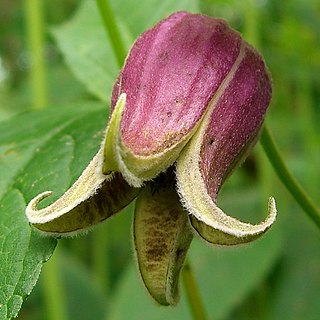
Clematis viorna, commonly known as vasevine or leatherflower, is a flowering vine native to the southeastern United States. It grows in wooded habitats and bears purple flowers in spring and summer.

Scutellaria brittonii, also known at Britton's skullcap, is a flowering perennial native to Wyoming, Colorado, New Mexico, Nebraska, and Kansas in the United States. It is classified under the genus Scutellaria and is also part of the mint family, Lamiaceae. It grows on dry mountain slopes and in full sun.
